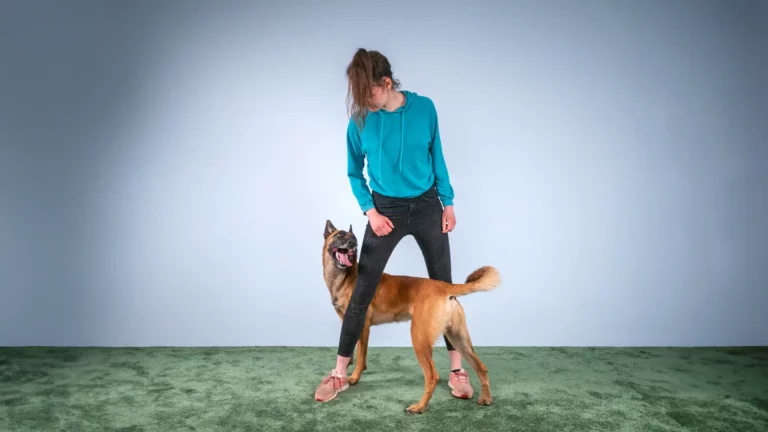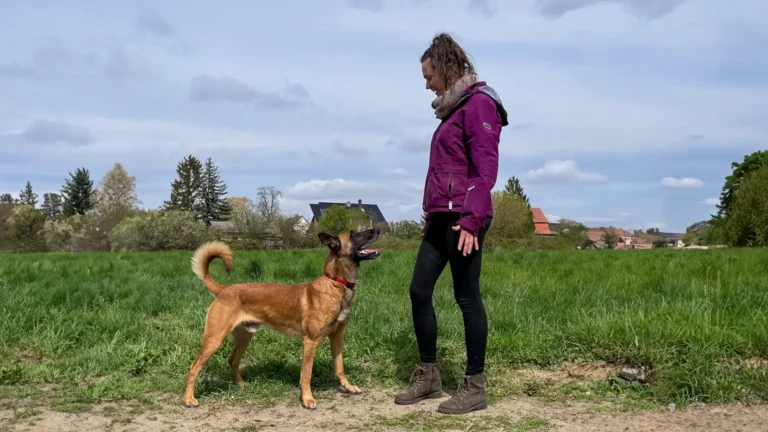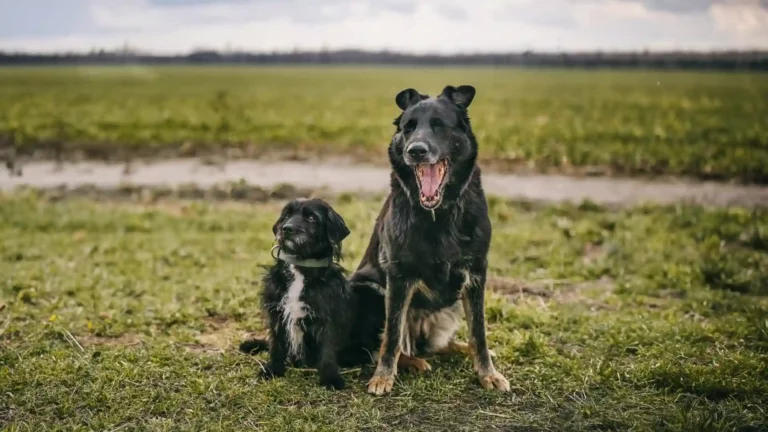Dog Psychology: Facts & Tips to Interpret Your Dog Better
- Anja Boecker
- Updated: 2023-12-05
It is not easy to understand another species. Therefore, it can be very difficult to make sense of your dog's behavior. This lack of understanding can cause problems. This article will help you interpret your furry friend's psychology.

It is important to develop a close relationship with your four-legged friend and to better understand their behavior. Dogs are remarkably intelligent. Of course, it cannot be compared to that of humans. We humans often lose sight of this fact.
We "humanize" our pets too much. This can be fatal. Because your pet communicates with you as an owner as much as with other dogs. This misunderstood communication can have many consequences.
For example, a poor human-dog relationship. This also affects your dog's mood. The result: aggression and stubbornness. Want to understand dog psychology better? Strengthen your relationship?
This article will help you! We have compiled some interesting facts about dog psychology. Five principles and tips to help you get along better with your beloved dog.
The Importance of Understanding Canine Psychology

Imagine if you could get inside your dog's head, understand his feelings, and interpret his actions. This is where canine psychology comes in - it is the key to a deeper and more fulfilling relationship between you and your four-legged friend.
Dog psychology deals with everything that goes on inside your dog - from his basic instincts to his complex emotions. By understanding canine psychology, we can not only communicate and train better, but also address and resolve behavior problems more effectively.
- Better communication: Understanding how your dog thinks and feels will help you communicate better with him. This is the foundation of all training and building a strong relationship.
- Recognize needs and feelings: The ability to understand your dog's emotional world is crucial to being able to respond to his needs. This ranges from recognizing fear to joy.
- Prevent and resolve behavioral problems: Many behavioral problems are the result of misunderstandings or unmet needs. A deep understanding of canine psychology helps to avoid or resolve such problems.
- Build a deep relationship: A relationship based on mutual understanding and respect is stronger and more fulfilling. Canine psychology helps you build such a relationship.
Understanding canine psychology can save you a lot of trouble. Your pet will feel that you understand him, which will strengthen your bond.
The Basics of Canine Psychology
Understanding canine psychology is like deciphering a secret language - it opens the door to a deeper connection and understanding between you and your four-legged friend. In this section, we'll look at the basics of canine psychology and shed light on patterns of behavior and what they mean.
1. Instinctive Behavior
Just like us, dogs have instinctive behaviors that are deeply rooted in their DNA. These include hunting, territoriality, and natural pack behavior. These instincts influence the way dogs respond to their environment and interact with others.
2. Learning and Adaptability
Dogs are extremely adaptable and willing to learn. They learn by observation, imitation and conditioning. This learning behavior is the key to successful training and adjustment to living with people.
3. Communication
Dog communication is multifaceted and includes body language, vocalizations, and even scent signals. Understanding these forms of communication is critical to correctly interpreting a dog's needs and emotions.
4. Social Interaction
Dogs are social animals by nature and their interactions, both with other dogs and with humans, are characterized by hierarchy and bonding. Social signals such as tail wagging, soothing yawns, and belly baring play an important role in their social relationships.
5. Emotional Behavior
Dogs experience emotions such as joy, fear, excitement, and sadness. These emotions affect their behavior and reactions to various situations. An empathetic understanding of these emotional states is essential to building a strong and trusting relationship with your dog.
This knowledge is the foundation for successful communication and a harmonious life with your dog. The next section will show you how to put this knowledge into practice.
Social Behavior and Bonding
The social behavior of dogs and the development of a strong bond with their owners are important aspects of canine psychology. Dogs are social creatures by nature, and their interactions with other dogs and people are critical to their well-being and development.
Dogs need social interaction with other dogs. Dogs learn a lot about social hierarchy, communication, and appropriate behavior by interacting with other dogs. Playing with other dogs is not only entertainment, but also an important part of social learning.
Dogs learn boundaries, self-control, and nonverbal communication through play. Dogs have a natural understanding of the dynamics within a pack that affect their interactions. It is important to respect and understand these dynamics.
The relationship between humans and dogs is unique and requires mutual understanding and respect. A strong bond is built on trust. Be consistent, patient and understanding with your dog. Learn to read your dog's signals and respond appropriately. This will strengthen your mutual understanding.
Build and maintain a strong bond. Spend time with your dog on a regular basis, whether it's playing, walking, or just relaxing. Exercising together strengthens the bond and mutual understanding. It also shows your dog that you are a dependable leader. Be there for your dog in good times and bad. Show empathy and understanding for his feelings.
Human-Dog Communication

Communication with your dog goes far beyond simple commands and responses. It is a subtle interplay of body language, vocalizations, and mutual understanding. In this section, we will explore the art of human-dog communication and look at the importance of body language and vocalizations.
Body Language
Body language is the primary way your dog communicates with you and his environment. It is the key to nonverbal communication. Every movement, every posture has meaning:
- Tail position: A wagging tail can mean joy, a tucked tail can mean insecurity or fear.
- Ear posture: Ears pricked up show attention, ears pricked back can signal fear or submission.
- Posture: A relaxed posture indicates well-being, while a tense or hunched posture may indicate insecurity or anxiety.
You can learn more about dog body language in this article: Dog Language: Tips to Understand Your Dog Better
Vocalizations
Dogs also communicate through a variety of sounds. It is more than just barking:
- Bark: Barking can have different meanings depending on the pitch, duration and context. It can express excitement, warning, readiness to play or discomfort.
- Whining or complaining: These sounds are often a sign of discomfort, desire or concern.
- Growl: Growling is a warning. It indicates that the dog feels threatened or is defending something.
Develop Mutual Understanding
The art of communicating with your dog is interpreting these signals and responding appropriately. It's about developing a sense of your dog's moods and needs:
- Watch and learn: Spend time observing your dog and learning its cues. Each dog is unique and has its own way of expressing itself.
- Answer consistently: Be consistent in your responses to your dog's communication. This will help him understand and learn what you want him to do.
- Mutual adaptation: Communication is a two-way street. Not only must your dog learn to understand you, but you must also learn to speak his language.
Understanding Dog Emotions
Dogs are not only loyal companions, but also emotional beings with a wide range of feelings. We will look at some of the emotions dogs experience - from joy to fear - and how we, as dog owners, can recognize, interpret and respond to them.
1. Recognize and Promote Joy
Joy is one of the most beautiful emotions you can observe in your dog. A happy dog often shows this through exuberant behavior such as jumping, playing, and running around happily. The dog has a relaxed body language: a loose and excitedly wagging tail and a relaxed body. Reward and encourage happy behavior with treats, petting, and positive attention. Provide play and fun. Regular playtime helps to promote and maintain the dog's happiness.
2. Recognize Anxiety and Stress
Anxiety and stress can affect your dog's health and behavior. Signs may include changes in body language such as tail tuck, ears back, and a hunched posture. He may show avoidance behaviors, such as trying to hide or escape the situation. Panting, trembling, or whimpering may be physical signs of discomfort. Create a calm and secure environment. Offer your dog a quiet place to retreat to. Speak in a soothing tone of voice and offer gentle petting to calm your dog. Try to find out what triggers the anxiety or stress and work to minimize or eliminate those triggers.
3. Curiosity and Interest
Dogs are naturally curious. They show their curiosity by being alert, sniffing and exploring their surroundings. Encourage exploration. Provide safe opportunities for your dog to explore his environment, such as taking him for walks in new areas. Stimulate the mind: Use interactive toys and training games to encourage your dog's mental stimulation.
4. Frustration
Frustration can occur when a dog encounters obstacles or his needs are not met. Signs may include restlessness, barking, or even destructive behavior. Determine the cause: Try to find out what is causing the frustration and work on a solution. Make sure your dog is physically and mentally engaged. Channel your dog's energy into positive activities such as training or play.
5. Aggression
Aggression in dogs is an important emotion that requires attention and understanding. It can occur for a variety of reasons, including fear, frustration, territoriality, or due to pain. Aggressive behavior can manifest itself in growling, snarling, staring, and in some cases, snapping or biting.
Tips for Dealing With Aggression:
- Understand the causes: Try to find out what triggers the aggression. Common triggers include fear, a protective instinct, pain, or past negative experiences.
- Seek professional help: If there are signs of aggression, it is important to seek professional help. An experienced dog trainer or behaviorist can help understand the causes of aggression and develop appropriate training strategies.
- Create a secure environment: Make sure your dog is in a safe environment where he does not feel threatened. Avoid situations that are known to trigger aggression.
- Use positive reinforcement: Train your dog using positive reinforcement methods rather than punishment or aggressive techniques that can make the problem worse.
- Health Check: Aggression can sometimes be caused by health problems. A visit to the vet can help to rule out medical causes.
- Keep calm: Stay calm and collected. Dogs can react to their owners' emotions, and staying calm can help defuse a tense situation.
- Watch and learn: Learn to read your dog's body language so you can recognize and respond to signs of discomfort or aggression.
Aggression in dogs is a complex behavior that often requires in-depth understanding and sensitive handling. A proactive approach and the inclusion of expertise are critical to effectively managing the behavior and ensuring the safety of all involved.
5 Tips to Understand Your Dog Better

Here are some of the best tips to help you understand dog psychology.
1) Dogs won't listen if they're scared
Dogs learn best by positive association and repetition. Fear is not only counterproductive in humans. Fear is also harmful to your four-legged friend. That's why the relationship between you and your dog should never be based on fear.
2) Consider Emotions
Recognize and take into account your dog's emotional state during training. Fear, stress, or excitement can interfere with the learning process.
3) Be Consistent With Rules
It is also important to apply a certain amount of rules in dog psychology and training. Of course, there needn't be rules everywhere. But too few rules are also harmful.
You should think ahead about which principles are most important to you and your dog. These rules should be clear and consistently enforced.
Use body language to communicate with your dog. Clear and calm signals will help your dog better understand your instructions.
4) Rewards and Praise as Positive Cues for Your Dog
Positive reinforcement means rewarding desired behavior instead of punishing undesired behavior. Rewards and praise can be given in the form of treats, petting, and cuddling. This should be the order of the day and integrated into the daily life between dog and human.
Positive reinforcement builds trust and a positive relationship between you and your dog. It creates a learning environment where your dog feels safe and motivated. Training methods based on positive reinforcement often produce better results in the long run. They promote your dog's cooperation and well-being.
Be consistent with your rewards. Always reward immediately after the desired behavior. Use a variety of rewards to keep training interesting.
5) Take Your Time
A dog-human relationship should never be a stressful one. Patience is the first priority. For example, when teaching your dog new methods or exercises, remember that it takes time.
Stress, pressure, or even aggressive training is out of place and a no-no. Be patient and avoid frustration if your dog does not respond immediately. Every dog learns differently.
Dog Behavior Problems: Understanding Causes & Finding Solutions
Every dog owner knows them: the little and sometimes big behavioral challenges of our four-legged friends. From excessive barking to destructiveness, behavior problems can take many forms. We look at the most common behavior problems and their psychological causes, and offer tips for solving and preventing them.
- Excessive barking: This can be triggered by anxiety, boredom, a need for attention, or as a response to environmental stimuli.
- Aggressiveness: Aggressive behavior can be triggered by fear, territoriality, pain, or previous negative experiences.
- Destructive rage: Often a sign of separation anxiety, boredom or lack of exercise.
- Pulling on the leash: May be caused by excitement, lack of leash training, or strong hunting instinct.
Each behavior problem requires an individualized training approach. Positive reinforcement and patience are the keys to success. Provide your dog with sufficient mental and physical activity to avoid boredom and its associated problems.
Create a calm and safe environment for your dog to reduce anxiety and stress. Early and regular socialization helps prevent many behavioral problems. For serious or persistent problems, consult a professional dog trainer or behaviorist.
Understanding and patience are key
It is important to understand that behavior problems are often a sign that your dog is not feeling well or that his needs are not being met. With understanding, patience, and the right approach, you can help your dog be his best self.
Dog Psychology and Dog Training
Dog psychology and dog training are closely related but distinct fields that deal with the behavior and training of dogs.
| Dog psychology | Dog Training |
|---|---|
|
|
In summary, dog psychology is the basis for a deeper understanding of dog behavior, while dog training is the application of specific methods and techniques to shape and direct that behavior. Both areas complement each other and are important for comprehensive and effective dog training.
8 Interesting Facts About Canine Psychology
We have researched some interesting facts for you. They will help you understand and learn more about dog psychology. This will help you better interpret your dog's reactions. You will also gain insight into your dog's psyche:
1) Dogs Have Dreams

It is believed that dreaming has the same function in dogs as it does in humans: The furry friend processes what it has experienced during the day. In this way, learned exercises or activities can be consolidated.
2) Who's a Smart Boy?
Dogs are intelligent creatures - almost everyone knows that. It is not for nothing that they are used by the police or as therapy and guide dogs for the blind. Their high intelligence also plays an important role in dog psychology.
Our four-legged friends can understand us better than other pets thanks to their keen perception. They also have more empathy and compassion for humans. According to canine psychologists, our furry friends have the intelligence of a two-year-old toddler. They can recognize between 150 and 250 words.
3) They Recognize Your Tone of Voice
Your pet's intelligence is able to recognize the keys of your voice. He understands them. Your dog knows exactly when he has done something wrong and you are reprimanding him. Perhaps you have seen his rueful look when he has done something wrong.
4) Yawning Doesn’t Mean Tired

Yawning is known everywhere as an expression of tiredness. But dogs yawn not only because they are tired. Yawning is also a way to relax and relieve stress. Has he had a particularly stressful day? Or has he been exposed to a lot of anxiety? Then your dog will yawn more often.
5) Dogs Are Social Animals
Almost every dog owner knows that dogs need social contact to be mentally balanced. However, it should be emphasized again at this point. Even if your pet loves you more than anything and you give him everything he needs, this will not curb his pack instinct. So take him to the park once or twice a week. Walk with other dog owners. Your sweetheart will thank you!
6) Barking Is Not Only a Warning
Dogs don't just bark when they're angry or aggressive.
Barking is a dog's primary means of communication and can have several meanings:
- A call for attention
- An expression of joy and gratitude
- A form of greeting
All in all, barking is not just a warning. There are other clues that can tell you more about why your dog is barking. Your pet's posture is an important sign to interpret this action.
7) Your Dog’s Posture Says a Lot
Body language includes wagging the tail, tucking the tail, or crouching. These signals can tell you a lot about your dog's well-being and mood. We have summarized the most important body postures and what they mean:
Your dog is wagging its tail: In most cases, tail wagging has a positive meaning. It expresses joy. Your pet may be in "play" mode.
Upright head position: An upright head position usually means your dog wants to play. The person he shows this position to should play with him.
Crouched posture: A hunched posture is the opposite of joy. Does your disciple have a hunched posture? This could mean that he doesn't like to do something or is afraid of something.
Tucked tail: This posture also expresses a tense situation for your pet. With its tail between its legs, it shows that it is afraid of something. This posture can also occur after being reprimanded for something.
Your dog is stretched out: This posture shows that your pet is relaxed and balanced. Your dog may adopt this posture, especially after a fun and active day.
8) Whining Is an Alarm
Is your dog howling? Then you can assume that he is very unhappy or even in pain. Under no circumstances is howling a positive sign. Your dog may use howling as a means of communication in the following situations:
- Your dog is missing a friend (human or animal)
- Being sad
- Going through pain
- Feeling unwell
In any case, the howling is a warning signal. Something has happened to your furry friend. Has a friend died or a caregiver moved away? Does your pet no longer see them? Then the howling is most likely due to loss and grief.
Does your faithful companion start howling for no reason? Then you can assume that he is uncomfortable or even in pain. In this case, you should take him to the vet immediately.
Frequently Asked Questions
Dogs can communicate to some extent with other dogs and humans through body language and sounds. This is primarily to communicate emotions.
If the corners of the mouth are pulled back, the dog is submissive. If it shows its teeth, it is threatening. If the lips are stretched forward, the dog is relaxed.
If your dog is twitching in his sleep, he is probably dreaming. It is thought that dreams serve the same function for dogs as they do for humans: to process what they have experienced during the day. They may reinforce exercises or activities they have learned.
An animal psychologist, who specializes in the behavior and psyche of animals, works in several steps:
- Observation and evaluation: The animal psychologist begins by carefully observing the animal in its natural or familiar environment to identify patterns of behavior.
- Medical history: He talks to the owner to understand the animal's history, past behavior, and possible changes.
- Behavioral analysis: Based on observation and history, the animal psychologist analyzes the animal's behavior to identify possible causes of problems or abnormalities.
- Intervention planning: The animal psychologist develops a customized plan that includes training methods, behavior modification, and sometimes changes in the animal's environment or routine.
- Implementation and training: The animal psychologist works directly with the animal and its owner to implement and train the recommended methods.
- Ongoing evaluation and adaptation: The animal psychologist regularly evaluates progress and adjusts the plan as needed to achieve the best results.
In short, an animal psychologist works through careful observation, analysis, and targeted intervention to resolve behavioral problems and promote the animal's well-being.
The cost of a dog psychologist can vary and depends on several factors such as the region, the experience of the psychologist, the complexity of the case, and the number of sessions required. The average cost is between 50 and 150 Euros per session. Some dog psychologists offer packages of several sessions at a reduced total price. It is advisable to obtain several quotes in advance to determine the exact cost and scope of services.
My Conclusion
Exploring canine psychology is an exciting and enriching journey that not only helps us better understand our dogs, but also deepens our relationship with them. By learning about their emotions, behaviors, and ways of communicating, we can build a stronger, more empathetic bond with our loyal companions.
The application of canine psychology to training, combined with positive reinforcement techniques, opens the door to an effective and enjoyable learning process. By learning to see the world from our dogs' perspective, we can better respond to their needs and enable them to live happy and balanced lives.
Remember that every interaction with your dog is an opportunity to expand your understanding and strengthen your bond. Be patient, be attentive and above all, be present in the moments you share with your dog. A relationship with your dog based on understanding and respect is one of the most rewarding aspects of living with a four-legged friend.
At this point we would like to reiterate that dog training and the resulting relationship should always be free of violence, aggression, impatience and stress.

My name is Anja Boecker, and I am a certified dog trainer and behavior consultant. With these articles, I want to help you to understand your dog better and to build an inseparable bond.
Share Now:


Yes that's right everything I like very much also describe what man has to do great